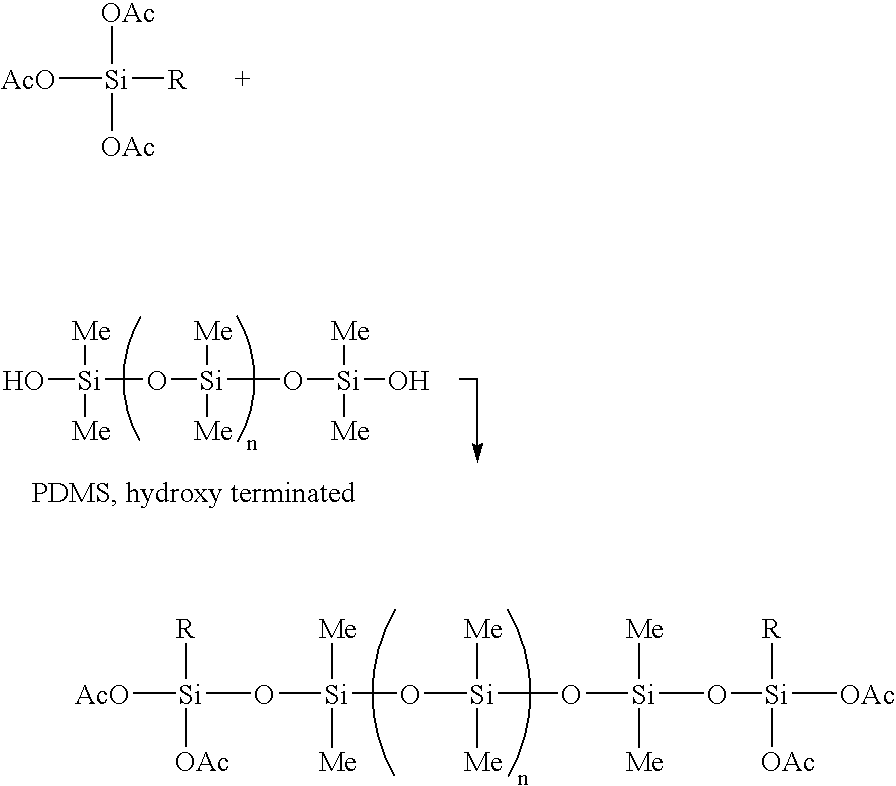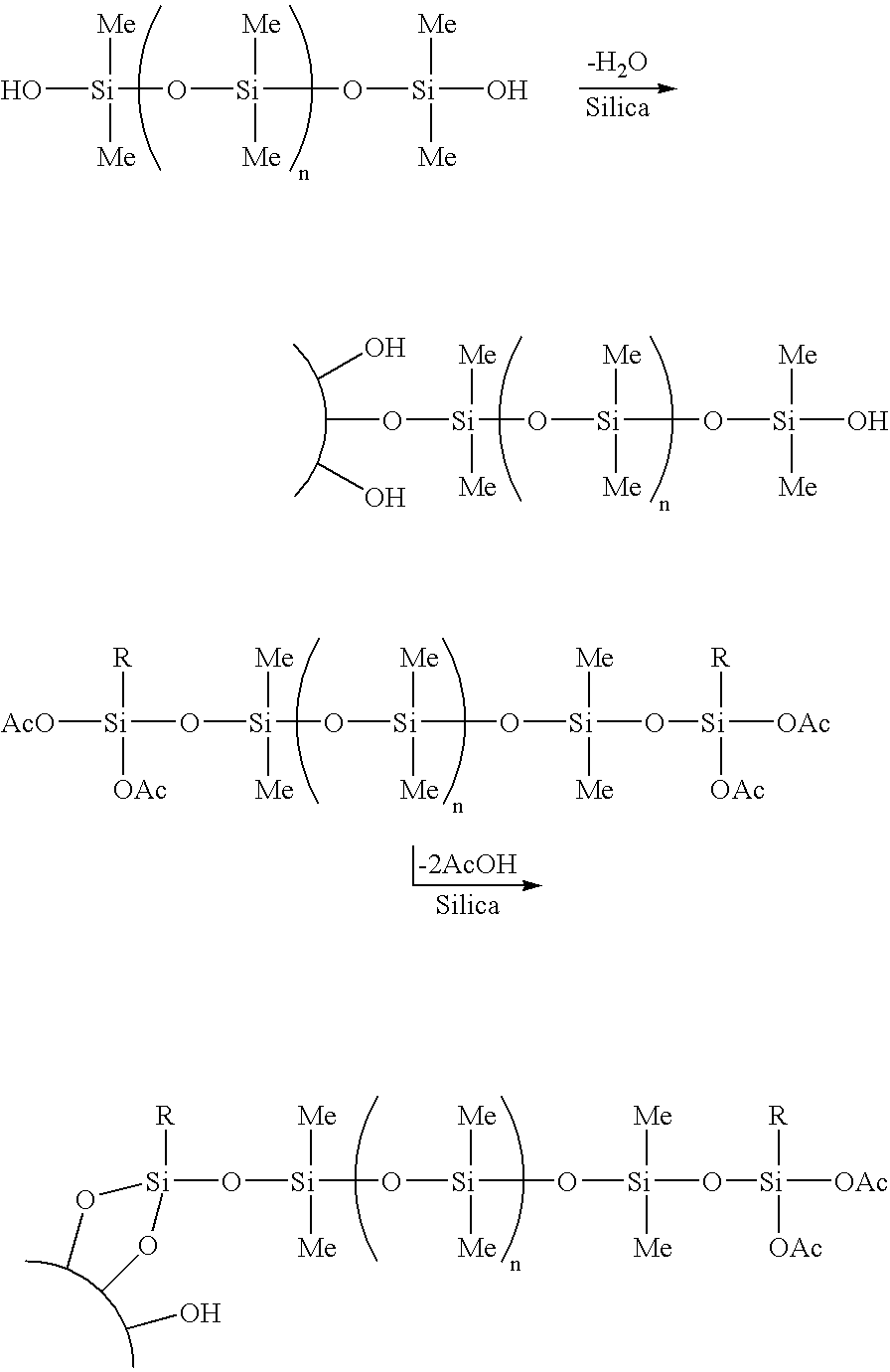Durable superhydrophobic coating
a superhydrophobic coating and coating technology, applied in the field of coatings, can solve the problems of superhydrophobic coatings formed by the methods described, the angle of water droplets on the surface can be increased, and the surface to become physically rough, so as to achieve the effect of durable and enhanced coating durability
- Summary
- Abstract
- Description
- Claims
- Application Information
AI Technical Summary
Benefits of technology
Problems solved by technology
Method used
Image
Examples
examples
[0089] In Examples 1 to 5 described below, the particulate material used was flame-hydrolysed silica powder having a primary particle size of 5 to 50 nm. The flame-hydrolysed silica powder used is Aerosil™ silica. The specific surface area of Aerosil™ silica is about 50-600 m2 / g. The large specific surface area represents an important characteristic of Aerosil™ silica. Since the specific surface area of the Aerosil™ silica is large in relation to the mass, the surface chemistry plays a significant role and influences the surface properties of the coating formed using such particles.
[0090] In the following examples, the contact angle and the hysteresis of water on the coated surfaces were determined by an automated contact angle instrument goniometer (made by Ramé-hart, Inc). The uncertainty in the measurements of the contact angle is ±5°.
[0091] In the following examples, the hardness and adhesion of the coated surfaces were determined as follows: [0092] (a) Hardness: Coating hardn...
example 1
[0111] In this example, a hydrophobic coating was formed on the surface of a glass and rubber substrate using a method similar to that in the above Comparative Example, except that the polymer strands formed by the linking agent (hydroxy terminated PDMS) were cross-linked via a free radical cross-linking reaction. The cross-linking reaction was catalysed by the presence of a large amount of peroxide.
[0112] The coatings were applied as follows:
[0113] The following were mixed together:
0.4 g PDMS (hydroxy terminated)CAS [70131-67-8]0.3 g methyltriacetoxysilaneCAS [4253-34-3]0.1 g dicumyl peroxideCAS [80-43-3]0.1 g Aerosil silica powder, and˜20 ml hexane[0114] The mixture was mixed well and vibrated in an ultrasonic bath for 15 to 30 minutes to disperse the particles and form a uniform mixture. Vibration frequencies of about 40 kHz were used. [0115] The mixture was removed from the ultrasonic bath. [0116] Without allowing the mixture to settle, drops of the mixture were deposited on...
example 2
[0129] In this example, a hydrophobic coating was formed on the surface of a glass substrate and a rubber substrate as described below. In this example, the linking agent was vinylsiloxane polymer (hydroxy terminated). This polymer includes vinyl groups which are able to react with methyl groups on the polymer strands formed by the linking agent via a free radical cross-linking reaction using a catalytic amount of peroxide.
[0130] The following were mixed together:
0.50 g vinylsiloxane polymer (hydroxy terminated)CAS [67923-19-7]0.36 g methyltriacetoxysilaneCAS [4253-34-3]0.03 g dicumyl peroxideCAS [80-43-3]0.12 g Aerosil silica powder, and˜25 ml hexane[0131] The mixture was mixed well and vibrated in an ultrasonic bath for 15 to 30 minutes to disperse the particles and form a uniform mixture. Vibration frequencies of about 40 kHz were used. [0132] The mixture was removed from the ultrasonic bath. [0133] Without allowing the mixture to settle, drops of the mixture were deposited on...
PUM
| Property | Measurement | Unit |
|---|---|---|
| particle size | aaaaa | aaaaa |
| particle size | aaaaa | aaaaa |
| particle size | aaaaa | aaaaa |
Abstract
Description
Claims
Application Information
 Login to View More
Login to View More - R&D
- Intellectual Property
- Life Sciences
- Materials
- Tech Scout
- Unparalleled Data Quality
- Higher Quality Content
- 60% Fewer Hallucinations
Browse by: Latest US Patents, China's latest patents, Technical Efficacy Thesaurus, Application Domain, Technology Topic, Popular Technical Reports.
© 2025 PatSnap. All rights reserved.Legal|Privacy policy|Modern Slavery Act Transparency Statement|Sitemap|About US| Contact US: help@patsnap.com



